Utah County Birders Newsletter
|
|
Dates
|
location
|
departure place and time
|
| May 12 | Utah county desert birds - Trip Leader: Eric Huish | day trip; leave Payson WalMart 7:00 a.m. |
| May 17-22 | Great Salt Lake Bird Festival | please make your own arrangements |
| May 26 | UCB Big Day - Trip Leader: Dennis Shirley | leave Provo East Bay Sam's Club 7:00 a.m. |
| June 9 (to be confirmed) | Oquirrh Mountains with Ann Neville | day trip; details TBA |
| June 22 & 23 | Grouse Creek mountains, NW Utah | overnight in Brigham City Friday night; details TBA |
| July 13 & 14 | Bryce National Park | details TBA |
Merrill's Musings
By Merrill Webb
Last week-end, April 20-21, I visited an old friend in southern Utah, a friend
that has been battered and abused. It disturbed me to see what has happened to
her. I don't know how long it will take her to recover--in fact, parts of her
may never recover during my lifetime.
I am referring to Utah's Mohave Desert west of St. George and the main riparian
community, Beaver Dam Wash that bisects that desert ecosystem. Fires and floods
have had a major, negative impact on the whole landscape. I grew up not too far
away from "the wash" as my dad used to refer to it, even hunted quail there when
I was a teen-ager, so I have a fond place in my heart for the area.
Now, Beaver Dam Wash is littered with the skeletons of large, dead cottonwoods,
uprooted and washed downstream by the torrents of flood water that ravaged the
area two years ago. Standing on the reconstructed bank of the irrigation pond at
Lytle Ranch I noticed a tree that had a yellow, metal sign nailed to it. The
large tree was lying horizontal in the dry, rocky channel and I couldn't make
out what the writing on the sign was. So I walked over to it. "The Nature
Conservancy Wildlife Preserve," it read. Before the flood I remember this tree
standing upright on the northern boundary of the Lytle Ranch Preserve about one
mile upstream from its present resting place. I walked up the dry stream bed
over rocks and litter not seeing a single bird. The main stream is just a
trickle to the west of me. As I reached the cottonwood forest I noted that some
of the understory vegetation that had been washed away has recovered a little
bit. There were a few scattered squawbushes under the cottonwoods, and a few
seep willows coming up along the main water course. The few cottonwood seedlings
that had germinated had been eaten down by cattle, relishing I suppose, the
little bit of greenery they can still find which is absent on the parched slopes
where cheat grass now abounds. Ahh, cheat grass, the alien invader that has no
nutritional value, and when dry serves as fodder for the next range fire.
And speaking of range fires have you seen what has happened to the vegetation on
the Beaver Dam Slope in the last two years? I'm referring to the area between
the old Highway 91 turn-off at Castle Cliff and the 11 miles or so of dirt road
you have to drive over to reach Lytle's Ranch. It is the part of the desert that
has been scarred by fire, leaving the Giant Joshua Trees charred skeletons
against the blue desert sky. Cholla, Ephedra, Yucca, black brush, creosote
bush--all gone. Totally. Well, almost totally. There are a few isolated pockets
of desert vegetation that the fire missed, but along the north side of the road,
most of the vegetation is gone--except the cheat grass, amber waves of cheat
grass, dry and ready to ignite when the next lightning bolt strikes the ground.
I recently visited with Dr. Stanley Welch, retired B.Y.U. taxonomist, and asked
him about the possibilities of recovery for this unique Utah plant community on
the slope. I was not encouraged by his response.
He indicated that cheat grass arrived in the West in 1894. Sometime later, two
other non-native annual grasses, red brome and Arabian grass, arrived on the
scene. The Mohave Desert never had annual grasses until these three invasive
species arrived. Plus, the vegetation of the Mohave Desert has never developed
under a fire regime. Now, when growing conditions are right including the right
amount of moisture at the right time of the year, these grasses grow rapidly and
abundantly. Then, during the summer they dry up. When lightning bolts strike the
ground during the summer thunderstorms these grasses ignite readily and the fire
spreads rapidly. Creosote bushes grow quite a ways apart and under normal
conditions aren't going to burn. But when the dry grasses are interspersed among
them, the fire spreads rapidly, burning the creosote, the blackbrush and the
Joshua trees. And none of these plants grow back by resprouting (like oak does).
They only grow from seeds. So, what is the prognosis? Dr. Welch paints a rather
gloomy picture when he says, that in his opinion, "the Giant Joshua and the
creosote will never recover. The black brush might recover, but it will take
50-100 years, if there are no more fires."
What has been the effect of fire on desert birds? It's not hard to imagine the
impact. Black-throated Sparrows have decreased in numbers. Same with Cactus
Wrens and Loggerhead Shrike. Scott's Orioles, which were never abundant
anyway--gone. On Utah Hill where finding Black-chinned Sparrows and Gray Vireos
was a given. It will require much more effort to find them now. There's no
vegetation left to support these avian populations.
How about the health of another important riparian community, the Santa Clara
Creek? Fire didn't quite reach the major channel area, but the floods had an
effect on cottonwood trees, uprooting some and washing away most of the
understory. But you can't blame the flood for the dearth of vegetation along the
stream channel. Not entirely, anyway. Try the City of St. George's thirst to
provide water for its golf courses and burgeoning population. They have buried a
pipeline right down the middle of the channel, diverting the water into the pipe
and dewatering the stream below the Gunlock Reservoir leaving the cottonwoods to
survive on a limited amount of rainwater. Without water they are more
susceptible to disease and to the tent caterpillars which had almost completely
defoliated the trees by last week-end. By comparison, the cottonwoods in the
Beaver Dam Wash, the ones that have survived the floods, had a few of the tent
caterpillar cocoons, but weren't completely defoliated. I even saw a Plumbeous
Vireo eat a couple of the caterpillars in a cottonwood tree along the wash.
Compare the numbers of birds on the Santa Clara Creek above the Gunlock
Reservoir where there is ample vegetation with the numbers of birds below the
dam where the vegetation is sparse and dying. Yellow Warblers and Lucy's
Warblers are quite numerous upstream from the reservoir. Below the dam, hardly
any.
So, what's to be done? "You know Mother Nature is a woman," Dr. Welch said,
referring to what the fires and floods have done to the habitat in Southern
Utah. "Always changing the furniture around." The implication is that we can't
do much about the floods and the fires, so adjust to it.
Nine years ago I did a quick study of the bird populations in a unique area
along the road to Motoqua, a small community abut 25 miles upstream from the
Lytle Ranch Preserve. The study area was an ecotone, which by way of definition
is where two or more different plant communities meet and integrate. The
vegetation was characterized by pinion-juniper trees, Joshua trees, black brush,
Yucca and great basin sagebrush. About twenty-fife years ago I remember
observing this unusual mix of desert vegetation for the first time, and thinking
how strange it was to see Giant Joshua interspersed among pinion pine trees and
great basin sagebrush. In 1998 I revisited this unique plant community four
different times during one breeding season and counted the birds at ten
different points along a two-mile transect. I ended up with a total of 29
different bird species, 18 of which I determined to be resident breeding
species.
I visited the same area last year (2006), one year after the fire had destroyed
the vegetation in every direction as far as the eye could see. I saw one bird--a
lark sparrow.
Dr. E.O. Wilson, a renowned Harvard biologist, in a presentation entitled "The
Future of Creation," given on February 28, 2007 at the University of Utah,
stated that there are five factors having a negative effect on biodiversity
worldwide. These five can be remembered by the acronym HIPPO: habitat
destruction, invasive species, pollution, population increase, and over
harvesting. On a relatively small scale I have seen the impact of three of these
factors in southern Utah in the last two years.
How does "Cheat Grass Biome" sound to you?
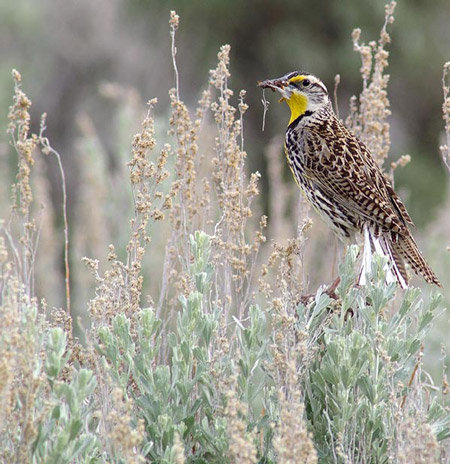 |
|
photo by Jim Huddle |
Western Meadowlark
Submitted by Alton
Thygerson
Scientific name: Sturnella neglecta
Meadowlarks are members of the blackbird family.
Meadowlark is
the state bird of:
Kansas, Montana, Nebraska, North Dakota, Oregon, and Wyoming
In 1844, John James Audubon commented on the “curious notes” uttered by meadowlarks along the upper Missouri River in today’s North Dakota. He observed that although the species was known to members of the Lewis and Clark expedition, no one had taken the “least notice” of these birds since. Therefore, Audubon named the western meadowlark Sturnella neglecta.
Field Marks:
• Chunky
songbird with a short tail -- shaped like a Starling
• Throat, chest, and belly yellow
• Black “V” across chest
• Back brown and streaked
• White outer tail feathers – shows patch of white on each side when it flies
• Several quick wing flaps alternate with short glides.
Differences between Eastern and Western Meadowlarks:
Westerns prefer drier grasslands and the Eastern chooses more moist locations. Only the Western is found west of the Great Plains. East of the Great Plains, the Eastern predominates although the Western has extended its summer range into the Great Lakes region and the Ohio Valley.
The two species are very difficult to tell apart. A key difference is the extent of yellow on the feathers below the eye. In the Western, the yellow feathers extend behind the lower jaw, while in the Eastern the yellow feathers top on the throat below the lower line of the lower jaw.
The songs of the two are very different. The Eastern has a simple, clear, slurred whistle while the Western’s song is complex, garbled and abrupt. Some describe it as a distinctive flute-like yodel. It’s a memorable song, produced by the males, performed to attract females, and is a proclamation to other males that the territory is occupied.
Habitat: Grasslands, pasture, and cultivated fields. Found across western and central North America to northern Mexico.
Migration: They are permanent residents throughout much of their range. Northern birds migrate to the southern parts of the range.
Utah County Locations: Fields east of Skipper Bay Trail (north of Utah Lake State Park), county’s pasture and agricultural areas which are more readily accessible in the southern part of the county.
Behavior: The male arrives at the breeding ground a couple of weeks before the female. It likes to perch on fences, poles and wires to claim and guard its territory. A male’s home range is about six or seven acres. If another male invades his territory, he may get into a fight with the intruder. Fighting meadowlarks lock their feet together and peck at each other.
When the male finds a female that he wants to mate with, he points his bill in the air, puffs out his yellow throat and flaps his wings above his head. If that doesn’t get the female’s attention, he hops up and down.
Feeding and Diet: Forages almost entirely on ground, gathering grain, seed, and insects. Feeds mostly on insects during the summer, grain in winter and early spring, and weed seeds in the fall.
Reproduction: Males often are simultaneously mated to two or more females. Females build a domed nest that is placed on the ground. An average of five eggs are laid late April-early August. Incubation is 13-14 days; fledging at about 10-12 days. Single brooded, but females renest if their first effort was unsuccessful.
Conservation Status: Not threatened. Widespread and common, but numbers declining in many areas. Agricultural practices affect breeding, destruction of nests by equipment and trampling of nests by livestock.
Interesting
Facts:
The Cornell Lab or
Ornithology gives these interesting facts:
• The nest is partially covered by a grass roof. It may be completely open, or it may have a complete roof and an entrance tunnel several feet long.
• Rarely do the Western and Eastern hybridize. Captive breeding experiments found that hybrid meadowlarks were fertile, but produced few eggs that hatched.
• When Western and Easterns nest in the same area, the Western male will defend his territory against all male meadowlarks of either species.
• The Western uses a “chase” display during pair formation, with the male chasing the female. The female usually starts the display, and she determines the speed of the chase. If a male has two mates, both females may participate in the display at one time.
References:
Alderfer, J. (2006). Complete Birds of North America. Washington, DC: National Geographic Society.
---------------------
[ The Bird of the Month is a new monthly column in our
newsletter. We will ask a club member (that’s you) to write about a bird each
month. Tuula Rose has agreed to coordinate the Bird of the Month column. If you
have a bird you want to write about let Tuula know before your bird is taken by
someone else. ]
Field Trip Report
Fish Springs, Callao, & Delta - 14 April 2007
by Lu Giddings
We had a great day of birding in the Great Basin yesterday. Five vehicles and 16
birders left the Payson Walmart at 6:00 a.m. and made the trek to Fish Springs.
After spending nearly six hours cruising the dikes and checking the picnic area
and the visitor's center, we made the drive to Callao and the Civilian
Conservation Corps camp in the eastern foothills of the Deep Creek Mountains.
From there we drove into Delta and stopped at several fields inundated with
irrigation water and also at Gunnison Bend reservoir. Many in the group who
lasted until sunset - when we finally called it a day - went home with 70-80+
bird species for the day. As a group, at least 93 species were reported. Trip
highlights included:
- a juvenile golden eagle sitting unconcernedly on a fence post about 15' away
from us as we drove past, just east of the IPP
- almost upon arrival we were treated to Savannah sparrows, black-throated
sparrows, sage thrashers, and American pipits in the sage flats to the south and
west of the NWR entrance
- the many dozens of nesting sandhill cranes, white-faced ibis, American white
pelicans, great blue herons, great egrets, snowy egrets, black-crowned night
herons, and cattle egrets in the south ponds at Fish Springs that were kind
enough to put on a real show for us
- two greater white-fronted geese and at least two greater scaup, the former at
the northeast end of Harrison pool, the latter in the pool to the south of
Harrison (thanks to Jack Skolicky for alerting the Sommerfelds to the geese!)
- the flooded fields in Delta, the first with many hundreds of gulls and waders,
the second with more long-billed curlews than I have ever seen in one place in
Utah. I counted 46 birds in one 20x scope field of vision, which covered less
than 25% of the birds present, while Steve Sommerfeld counted over 60 curlews in
one binocular field of vision in the same place.
- a pair of courting Clark's grebe's dancing together on Gunnison Bend
reservoir.
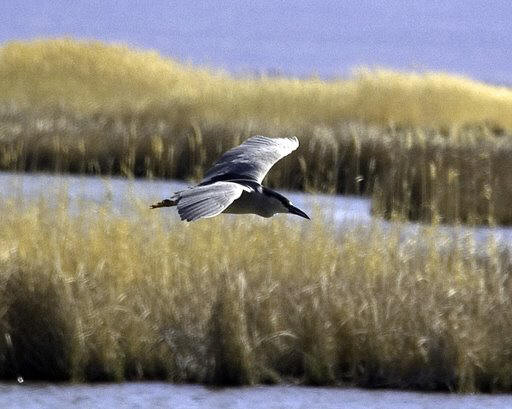 |
|
Black-crowned Night-Heron at Fish
Springs - 14 April 2007 |
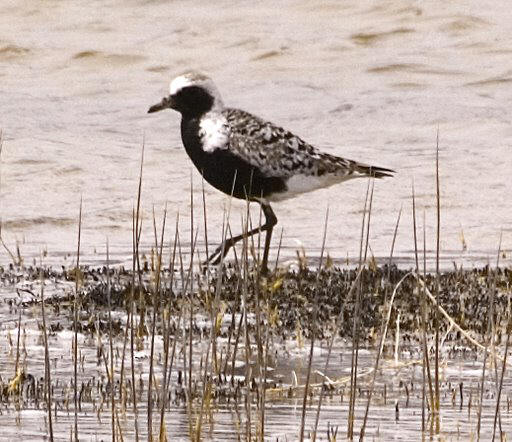 |
|
Black-bellied Plover - Fish Springs -
14 April 2007 |
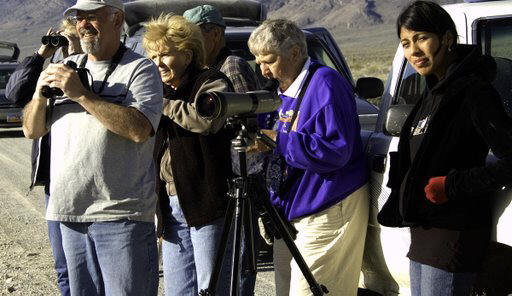 |
|
Milt, Carol, Bonnie and Stephanie at
Fish Springs - 14 April 2007 |
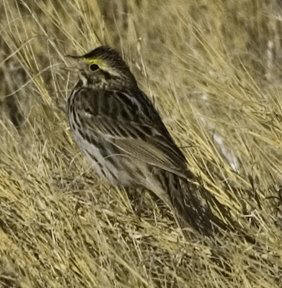 |
|
Singing Savanna Sparrow |
Many thanks to those of you who made it such an enjoyable day! Trip
participants included:
Ned Bixler
Yvonne Carter
Lynn Garner
Eric Huish
Stephanie and Matt Mills
Milt Moody
Carol Jean Nelson
LeIla Ogden
DeLoy Park
Tuula Rose
Cindy and Steve Sommerfeld
Reed Stone
Bonnie Williams
And finally, a few photos from the field trip may be
seen here.
Lu Giddings
Total Count: 93 species
Greater White-fronted Goose
Snow Goose
Canada Goose
Gadwall
American Wigeon
Mallard
Cinnamon Teal
Northern Shoveler
Northern Pintail
Green-winged Teal
Canvasback
Redhead
Ring-necked Duck
Greater Scaup
Lesser Scaup
Bufflehead
Common Goldeneye
Common Merganser
Ruddy Duck
Pied-billed Grebe
Eared Grebe
Western Grebe
Clark's Grebe
American White Pelican
Double-crested Cormorant
Great Blue Heron
Great Egret
Snowy Egret
Cattle Egret
Black-crowned Night-Heron
White-faced Ibis
Turkey Vulture
Northern Harrier
Swainson's Hawk
Red-tailed Hawk
Golden Eagle
American Kestrel
Peregrine Falcon
Prairie Falcon
Virginia Rail
American Coot
Sandhill Crane
Black-bellied Plover
Killdeer
Black-necked Stilt
American Avocet
Greater Yellowlegs
Lesser Yellowlegs
Willet
Long-billed Curlew
Marbled Godwit
Semipalmated Sandpiper
Wilson’s Snipe
Franklin's Gull
Bonaparte's Gull
Ring-billed Gull
Californian Gull
Rock Pigeon
Eurasian Collared-Dove
Mourning Dove
White-throated Swift
Belted Kingfisher
Northern Flicker
Say's Phoebe
Loggerhead Shrike
Black-billed Magpie
American Crow
Common Raven
Horned Lark
Tree Swallow
Violet-green Swallow
Northern Rough-winged Swallow
Bank Swallow
Cliff Swallow
Barn Swallow
Marsh Wren
American Robin
Sage Thrasher
European Starling
American Pipit
Yellow-rumped Warbler
Vesper Sparrow
Black-throated Sparrow
Savannah Sparrow
White-crowned Sparrow
Red-winged Blackbird
Western Meadowlark
Yellow-headed Blackbird
Brewer's Blackbird
House Finch
Lesser Goldfinch
American Goldfinch
House Sparrow
Field
Trip Report
Capitol Reef & Torrey - 28 April 2007
by Lu Giddings
Seven birders had a great time in Sevier and Wayne counties yesterday
afternoon and today. Perfect weather, beautiful country, and great birds made
the drive more than worthwhile. A partial list of the places visited includes
Richfield, Sigurd, Koosharem reservoir, Fish Lake, Loa, Fremont, Bicknell and
Bicknell Bottoms, Torrey, Teasdale, Boulder Mountain, the Fruita district of
Capitol Reef, and the Fremont River as it runs east out of the National Park.
Trip highlights include the following:
- a Lucy's warbler was observed in a grove of mature cottonwood trees on Highway
24, along the Fremont River and about 2.5 miles east of the Notom road. This is,
as far as I know, the most northerly sighting of a Lucy's warbler in Utah, and
the first reported sighting of which I am aware in Wayne county. In this same
stand of trees we also observed an ash-throated flycatcher, an olive-sided
flycatcher, a yellow warbler, an orange-crowned warbler, a plumbeous vireo, and
a female black-chinned hummingbird constructing a nest.
- several Grace's warblers were heard singing in the Single Tree campground on
Boulder Mountain. In this general vicinity we also observed red-breasted
nuthatches, white breasted nuthatches, pygmy nuthatches, Clark's nutcrakers,
Cassin's finches, and red crossbills.
- the sighting of a bald eagle and also, later, a golden eagle in the Bicknell
Bottoms area. Numerous waterfowl species were also seen in this area, along with
great and snowy egrets.
- Koosharem Reservoir was just ducky! While American coots were easily the most
abundant species on the water, in total numbers they were matched by many
hundreds of various waterfowl species, including a pair of greater scaup seen
this afternoon and a pair of common loons.
- Fish Lake had five pairs of common loons and an osprey.
- a number of first-of-year observations of common birds were enjoyed, including
Wilson's phalaropes, black-throated gray warblers, yellow warblers, lark
sparrows, and Bullock's orioles.
Thanks for a great trip and good company to Larry Draper, Sue Hinde, Eric Huish,
Milt Moody, Tuula Rose, and Merrill Webb!
Lu Giddings
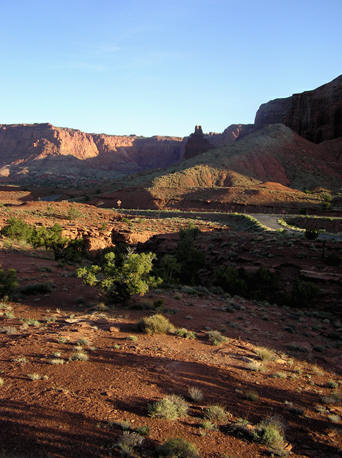 |
|
Capitol Reef National Park - 28 April
2007 |
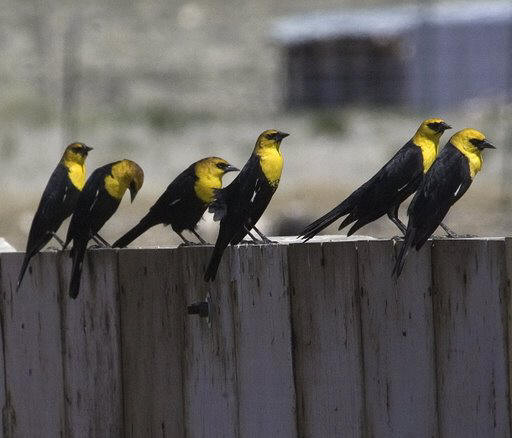 |
|
Yellow-headed Blackbirds near Bicknell
- 28 April 2007 |
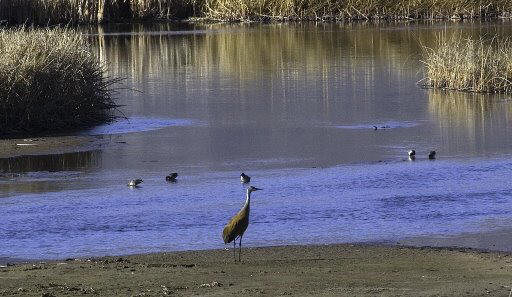 |
|
Bicknell Bottoms - 27 April 200007 |
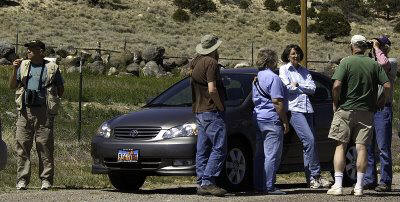 |
|
Where to next?
|
A partial trip list of the birds observed by one or more trip participants in
Sevier and Wayne counties is as follows:
Total Count: 112 species
Canada Goose
Tundra Swan
Gadwall
American Wigeon
Mallard
Blue-winged Teal
Cinnamon Teal
Northern Shoveler
Northern Pintail
Green-winged Teal
Redhead
Ring-necked Duck
Greater Scaup
Lesser Scaup
Bufflehead
Common Merganser
Ruddy Duck
Ring-necked Pheasant
Common Loon
Pied-billed Grebe
Eared Grebe
Western Grebe
American White Pelican
Double-crested Cormorant
Great Blue Heron
Great Egret
Snowy Egret
Cattle Egret
Turkey Vulture
Bald Eagle
Northern Harrier
Sharp-shinned Hawk
Swainson's Hawk
Red-tailed Hawk
Golden Eagle
American Kestrel
Virgina Rail
Sora
American Coot
Sandhill Crane
Killdeer
Black-necked Stilt
Wilson's Phalarope
Franklin's Gull
Californian Gull
Rock Pigeon
Eurasian Collared-Dove
Mourning Dove
White-throated Swift
Black-chinned Hummingbird
Belted Kingfisher
Red-naped Sapsucker
Northern Flicker
Olive-sided Flycatcher
Say's Phoebe
Ash-throated Flycatcher
Western Kingbird
Loggerhead Shrike
Plumbeous Vireo
Steller's Jay
Western Scrub-Jay
Clark's Nutcracker
Black-billed Magpie
Common Raven
Horned Lark
Tree Swallow
Violet-green Swallow
Northern Rough-winged Swallow
Bank Swallow
Cliff Swallow
Barn Swallow
Mountain Chickadee
Red-breasted Nuthatch
White-breasted Nuthatch
Pygmy Nuthatch
Rock Wren
Bewick's Wren
Marsh Wren
Ruby-crowned Kinglet
Mountain Bluebird
Townsend's Solitaire
American Robin
Northern Mockingbird
Sage Thrasher
European Starling
American Pipit
Orange-crowned Warbler
Lucy's Warbler
Yellow Warbler
Yellow-rumped Warbler
Black-throated Gray Warbler
Grace's Warbler
Spotted Towhee
Chipping Sparrow
Vesper Sparrow
Lark Sparrow
Savannah Sparrow
Song Sparrow
Lincoln Sparrow
White-crowned Sparrow
Dark-eyed Junco
Red-winged Blackbird
Western Meadowlark
Yellow-headed Blackbird
Brewer's Blackbird
Bullock's Oriole
Cassin's Finch
House Finch
Red Crossbill
Lesser Goldfinch
American Goldfinch
House Sparrow
Backyard Bird of the
Month
April 2007
Steve Carr - Holladay
Canada Goose - Never seen so many flying over as in April.
Eric Huish - Pleasant Grove
Yellow-rumped Warbler - Brightly colored male singing loudly.
Milt Moody - Provo
Cassin's Finch, 2 Males, 1 Female - it's been a while since I saw them in
my yard.
Bruce Robinson - West Jordan
Dark Eyed Junco - A little slow heading back to the mountains.
Reed Stone - Provo
Green-tailed Towhee - scratching and feeding.
Alton Thygerson - Provo
Northern Flicker - loud drumming on the neighbor's gutter rattles the
neighborhood and me out of sleep.
Bonnie Williams - Mapleton
American White Pelicans - My 100th backyard Bird!
We would like you to share your favorite backyard bird each
month. Please send your favorite bird at the end of the month to
newsletter@utahbirds.org or call 360-8777. If you would like a reminder at
the end of the month e-mail the above address.